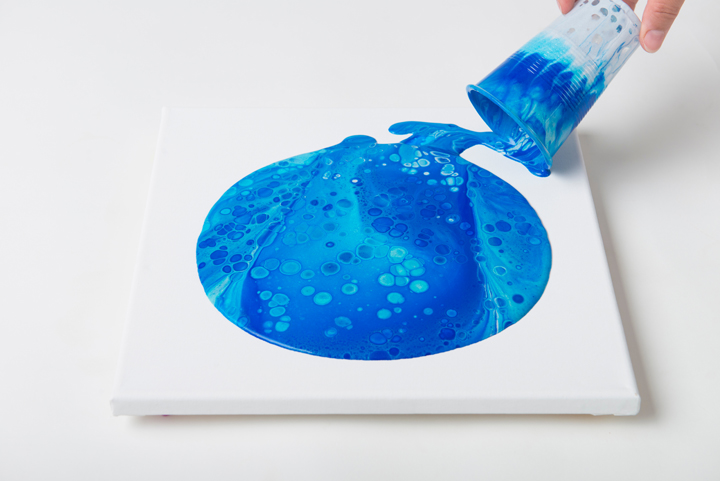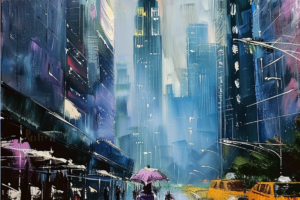Paint pouring is an exciting journey of artistic creativity. Blend different colors of paint and pour these on canvas. The many unexpected outcomes are a surprise.
The free flow of paints is mesmerizing to look at. Learning the skills is fun, and your imagination is your only limitation.
Paint pouring techniques work best with quick-drying acrylic paints. Pouring techniques are straightforward. Puddle pouring gives a marbled or kaleidoscopic effect. Artists and craft people represent the sky, ocean, seasons, and mountains through paint pouring. Trauma therapy uses paint pouring.
Paint pouring techniques are simple and used for a variety of reasons. The puddle pouring method is part of art therapy. There are magical and whimsical aspects associated with this form of art.
The quality of the paint colors sets the mood in paintings. Water-based acrylic paints are the easiest to use.
Paint Pouring Techniques
The various paint pouring techniques range from being straightforward to more advanced ones. Each technique has its degree of simplicity and difficulty.
For some, paint pouring is playing like a child. Others work to master the techniques and fine-tune artworks and crafts. There’s a history to this art form that’s rich (see below).
Paint pouring has different names, which depend on people’s attitudes. Some call the paint technique fluid acrylics after the kind of paint used and how the paint flows on canvas. It’s also called a ‘journey pour.’ This describes the fascinating and mesmerizing flow of paint on canvas.
The earliest exponent of the painting technique called it ‘accidental painting.’ Let’s see where it started.
Short History Of Paint Pouring
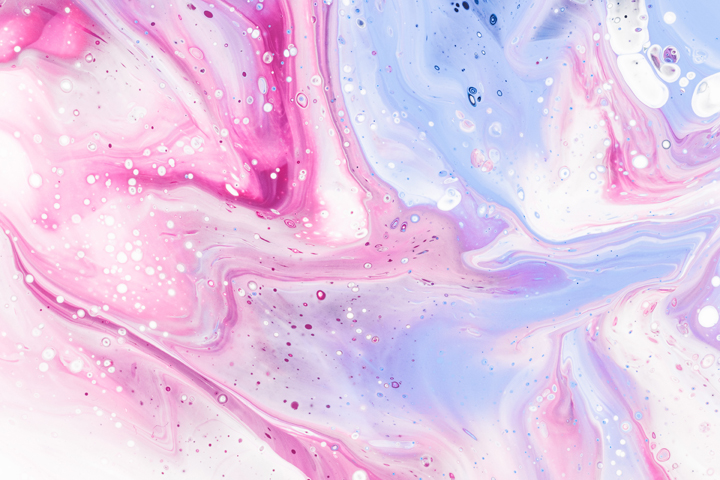
Mexican artist David Alfara Siqueiros is the founder of the paint pouring technique. He called this technique ‘accidental painting’. In the 1930s, Siqueiros (a muralist) experimented and added substances to paint colors.
He wanted to see if he could change the viscosity without changing colors. His interest in the thickness of paints was soon to influence others too.
His artist friend, Sandra Santina, got involved and spoke to a physicist. Together they came up with a physics of paint pouring based on paints’ densities.
Santina found that different additives did change the viscosity. Getting the paint to be thinner in texture and not alter the intensity of the colors was the aim. This was the birth of paint pouring.
Soon they looked at other technicalities, like how far to hold one’s hand from the canvas when pouring the paint. But for sure, a new art form was starting.
Even American artist Jackson Pollock joined the studio and studied under Siqueiros. He, too, mastered the paint pouring technique in his own way. His signature paint technique involves casting color on walls.
Siqueiros’ work inspired singer Janis Joplin’s Joplin’s custom-painted 1960s Porsche. Many other modern movements use this technique too. Another off-spring is art therapy, which uses paint pouring to cope with stress. Paint pouring increases self-awareness as people can express their feelings.
There are many techniques, each with varying degrees of difficulty. The artist or craftsperson decides depending on what they want to achieve. Mastering the basics gives the foundation for developing your own techniques too.
Acrylic Pour Painting Ideas
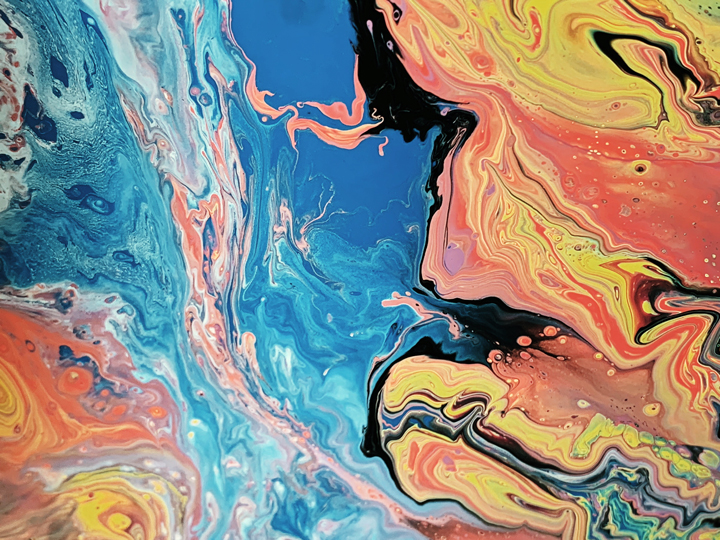
Paint pouring from the start involved experimenting with the thickness of paints. As the paint is thick, you have to dilute it to pour paint. The texture of the paint changes as you add substances.
You can dilute water-based acrylic paints with water or a pouring medium. Thinning the paint changes the consistency, but the color pigments are not altered.
There are many different techniques and levels of skill. And, though paint pouring looks simple, it takes skill to perform. Artists and crafters use innovative ideas and expand on these techniques.
Artworks of the late sixties associated with psychedelia used this poured paint look.
What Is Acrylic Pour Painting?
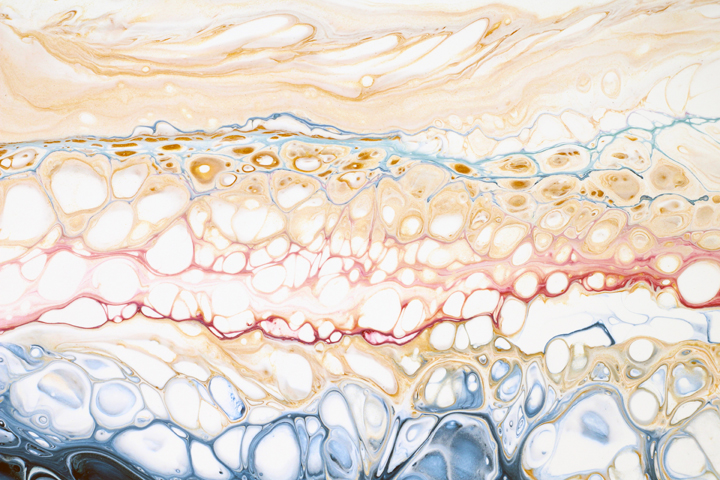
Acrylic pour painting is an abstract art form. You can use fluid acrylics and pour these onto a canvas (or other surfaces). The outcome is to create unique abstract effects.
You can use any acrylic paint. For the heavier-bodied acrylics, you have to use water or a pouring medium to thin these. Acrylics that are thinner in texture need less water or pouring medium added.
The traditional pour is the most used way of pouring paint on a canvas. The acrylic paint is liquid, like runny honey, and cast onto the canvas. Pour the paint in line strokes from one side of the canvas to the other.
This is a good starting point for beginners. Paint pour enthusiasts say this is the start of an enjoyable journey.
Also, choose acrylics with high pigmentation for vivid colors in your artworks.
Different Types Of Acrylic Pours
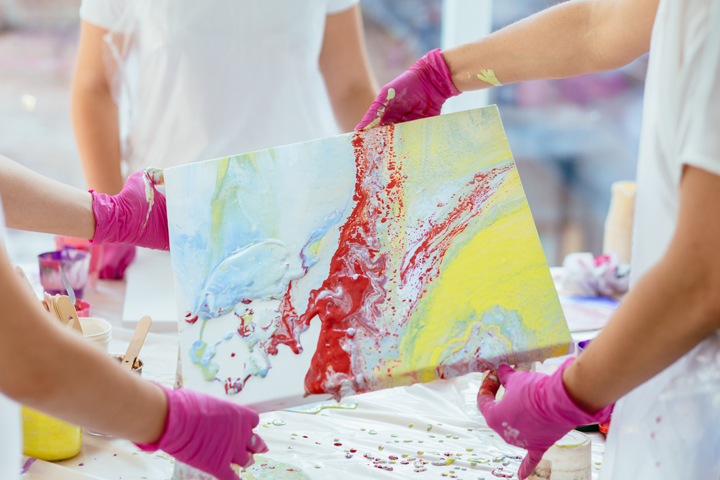
The best way to know how to use acrylic pours is to experiment. People get skilled in the basic techniques and then try out their own ways. The paint pouring technique suits all ages.
This experimental art technique is fun. Many use paint pouring to make artworks, paintings, and even craft items to sell at markets.
Paint pouring is individual as each person gets different results. These create different moods too.
This art form, as the basis for self-expression, brings about self-awareness. All ages can learn to do paint pouring.
The simplest of the paint pouring techniques is the clean or traditional pours. Pour the thinned acrylic paint in a streaky way across a canvas. The choice of colors is what you fancy.
Once done, pick up the canvas and twist it from side to side to have the paint run into adjacent colors and blur. Use a cold air blower or even a straw to form patterns of overlapping paint.
The most used technique in art therapy is puddle pouring. Some say this technique has the same relaxing feel as blowing bubbles and seeing them float away. Here, the colors that you see don’t drift like bubbles but expand and develop on the canvas.
Puddle Pour Technique
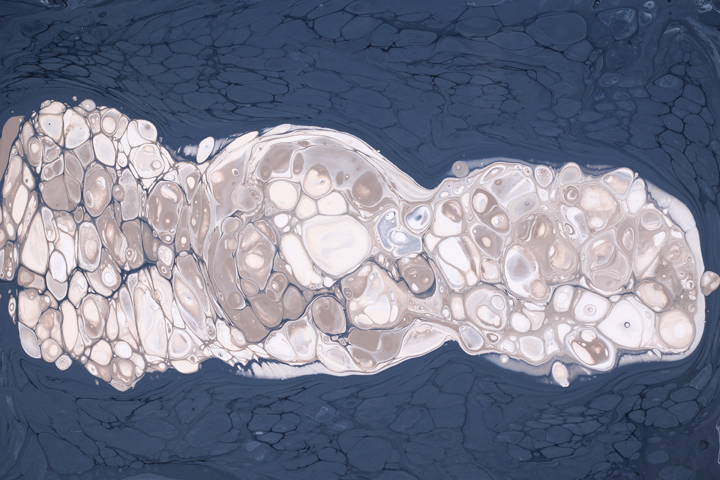
The puddle pour technique is like that of the traditional pour. Puddle pour is a colorful technique and a relaxing art form right from the start. As the process develops, it becomes hypnotic too.
Get a canvas, choose the acrylics you want to work with, turn on ambient music, and you’re ready to let go and create.
Fill individual pots with different colors. Select 7-8 different colors and water these down (a 1:1 ratio of paint and water). Pour puddles in a few single colors on the canvas.
Add a second color to the middle of these puddles. Build up more colors in the center. The puddles will look like striking eyespots or ocelli on peacock feathers.
You then repeat the process and add more puddles. You can alternate the layers of paints and cover the whole canvas. This spell-binding technique is a colorful array of eyes (the pools of color).
At this stage, most enthusiasts agree, the magic starts. You lose yourself in the paint pouring process.
As the puddles expand and overflow, there is a fun next stage. Use the back of a paintbrush to drag this through the center of each puddle. The colors part and distort the circles (eyes) and run in the direction of the paintbrush.
Some fanciers comment on the hypnotic feel of these techniques. Each stage of paint pouring is slow. Each step also looks so good that one wants to stop. But don’t; the next ones are rewarding.
Puddle Pour Tilting
The next stage takes a bit more skill. The small initial pools of paint, layered, stretch out lengthwise across the canvas. Lift the canvas and tilt it to have the layered multi-colored puddles merge even further.
This part of the puddle pouring technique is the part described as psychedelic.
The viscosity of the paint stops the paint from running off the canvas. The density also aids what looks like the stretching of the color across the canvas. The puddles expand in different shapes.
These elongated shapes form across the canvas. You can even tilt the canvas to run the paint patterns down the sides.
Puddle Pour Blowing
The various elements of the puddle pour technique overlap with others too. You need to blow to have enough air along the edges; you can determine the outcome or look.
You can also use a metal straw and blow the color along the edges to form new shapes. This is a gentle way of getting the formation of the puddles to change.
Most people doing puddle paint pouring sees this as a beginner’s technique. But the method has been fine-tuned. Many artists use these techniques to develop landscape pictures, water, and seascapes.
Easy Acrylic Paint Pour Techniques
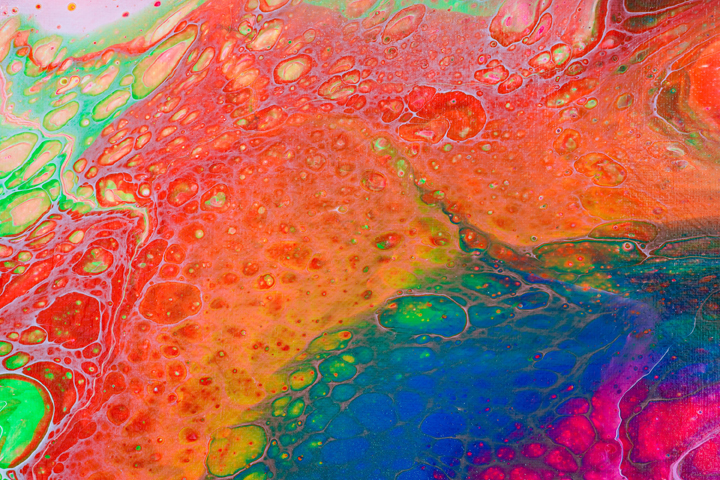
The acrylic paints are the best and easy to mix for easy paint pouring techniques. Among the easiest ones I’ve seen is the Dutch pours. This is simple.
Start with a single puddle of color in the middle of a canvas. Then add colors. You can watch the puddle (layered in colors) expand and spread across the canvas. Wait for the right moment to do the tilting.
With tilting, the paint flows in all directions. Quite often, black is a dominant feature. As you tilt and get the colors to flow, black will cover all the colors.
Don’t despair, though, as this is the next stage. You can add a few more colors to the black canvas. Then the fun starts.
Use a handheld air blower to peel or blow back layers of paint. This part of the process is to open up or reveal the colors underneath. As the paint is wet and fluid, the colors at the bottom show and wash back across the black surface. The colors spread like a beautiful flower or iridescent sunset across the canvas.
Other easy paint pouring techniques work in the same way. Once the paint is on the canvas, encircle the designs in a thick black outline. Add some white accents. And allow the black to wash over the color. Blow the colored paint out over the black to wash out to the edges. Again use a blower to open up or reveal the color.
Step By Step Acrylic Pouring
There are many youtube videos to start you off. And, as this kind of art form is inexpensive and has plenty of fun, don’t overlook that it can be messy. Use a pair of gloves and cover the surface you’re working on in a throw-away plastic sheet.
You can start out by thinning down acrylic paints or using liquid acrylics. In plastic cups, spoon a tablespoon of paint into each cup and an equal amount of pouring medium. To make your own pouring medium use a 50/50 mix of water and glue oil in a squeeze bottle. Mix the paint to the consistency of buttermilk or warmed-up honey.
With your canvas in place, start your acrylic paint pour, one color at a time. You might not have a plan but do spread the colors across the canvas. Don’t put too much paint on one area. And don’t pour out all the paint at the same time. Keep some in cups.
Once you’ve poured colors onto the canvas, pick it up and start to move the paint around. Though you don’t have complete control, you can guide the flow of paints by tipping the canvas.
You can get the paint to flow in the direction you want. This is the fun part, and you don’t know how it will turn out.
After spreading the paint across the canvas, you can see where to add more of the colors. And again, tilt the canvas. Allow the paint to run to the edges and cover the whole area.
If the paint does not flow too well, you can use an old gift card and scrape the paint in the direction you want.
To end this basic technique, you use rubbing alcohol in a spritzer bottle and spray this over the artwork. This is to pop any air bubble that might have formed. Leave the work to dry.
This can take up to two days. As the paint dries, the picture changes, and it is always a fun surprise to see what it looks like after it’s dry.
Other Acrylic Pour Art Techniques
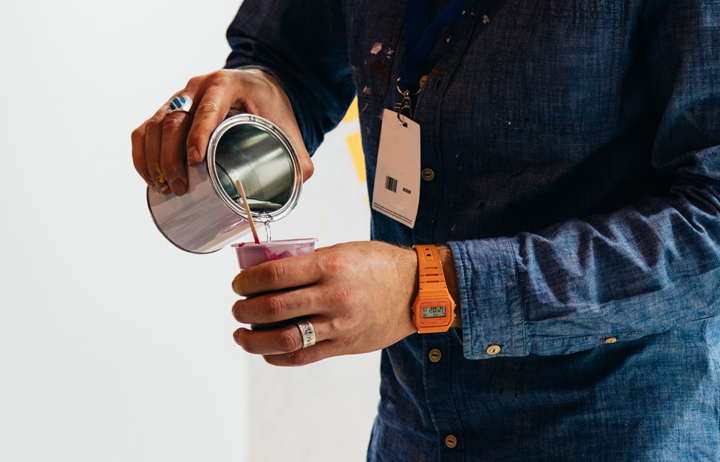
There is a history of knowing how to gauge the viscosity and fluidity of acrylic paints. This has led to the different techniques for pouring paint. Like traditional pours and the puddle pour techniques, the standard ones are popular.
There have been others whose names are descriptive and say almost exactly what they are.
The Flip Cup Technique is what its name says. Fill a cup with paint and put it upside-down on a canvas. In this case, you’ll use ½ cup of pouring medium (with a few drops of silicone oil) and then fill the cup up with layers of paint.
Don’t stir the colors. Cover the top of the cup with a cut-out piece of cardboard larger than the cup.
Tip the cup over onto the canvas and remove the cardboard. Then lift the cup and watch your psychedelic art develop as with all other techniques. The paint flows to the corners.
There are at least ten fun techniques to watch on YouTube, like tree ring pour, wine pour, and a swipe technique.
There are endless ideas of what you can do by using acrylic paints and pouring these on a canvas.
Paint Pouring Tips
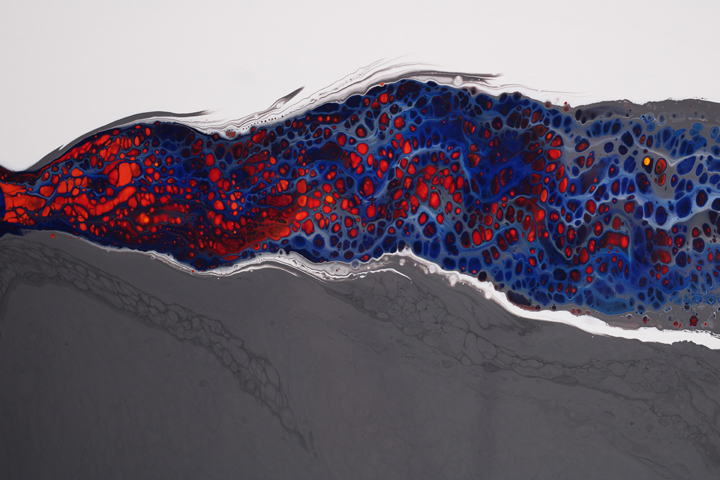
Keep in mind that it is good to know the different acrylic pouring and mixing techniques. This helps to achieve the best color consistency when pouring. Know the steps and when to intervene in the flow of the paint. Also, when to stop and know the artwork is complete.
Make sure the consistency is correct before you start pouring the paints. And pour the paint near to other strips without blurring paints. Blurring can be intentional.
Hold the canvas with both hands when tilting to get the color to run. And, don’t overdo the air blowing.
You can use a knitting needle or a toothpick to work within the colors and move these closer to one another. You can drag the different colors (from either side) over the other in a swirling effect for a marbled look.
Don’t pour the paint mix too thick, as the artwork will crack. If bubbles are in your painting, use a toothpick or pin to pop bubbles. Or you can use the fine mist of rubbing alcohol to pop these.
Some artists use a small blow torch too. Best though to get bubbles out before pouring by letting the paint stand.
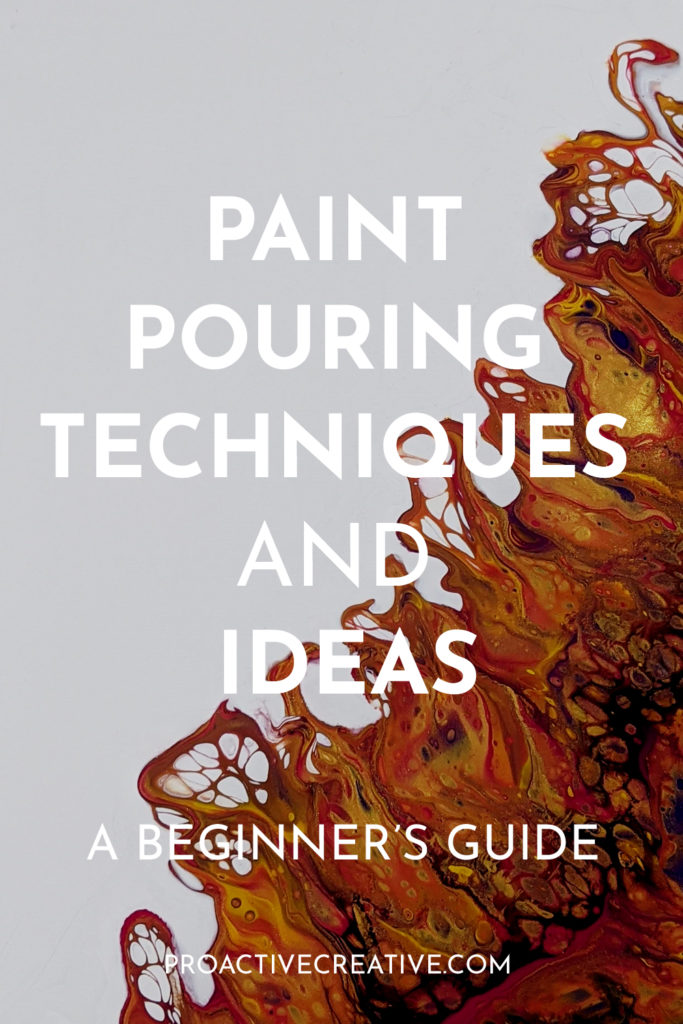
Conclusion
If only for therapy, do try out paint pouring’s many art techniques. Paint pouring is an experimental art form described as both fantasy and whimsy. The earliest forms had a psychedelic appeal and influenced iconic artworks.
Paint pouring techniques are rewarding on a personal level. Some say even eye-opening in the beauty of how these techniques reproduce many patterns you see in everyday life.
Think of the ripples of water, cloudscapes, and autumn trees’ leaves. If you lack inspiration, your paint pouring can surprise you.
Follow Proactive Creative on Pinterest for more arty tips, reviews, and tutorials!

